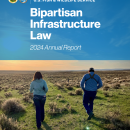SOUTH LAKE TAHOE, Calif. — Today, the U.S. Fish and Wildlife Service announced an additional $3.1 million in funding from the Bipartisan Infrastructure Law Bipartisan Infrastructure Law
The Bipartisan Infrastructure Law (BIL) is a once-in-a-generation investment in the nation’s infrastructure and economic competitiveness. We were directly appropriated $455 million over five years in BIL funds for programs related to the President’s America the Beautiful initiative.
Learn more about Bipartisan Infrastructure Law for existing cooperative agreements with the Washoe Tribe of Nevada and California and the Tahoe Regional Planning Agency to prevent and combat the spread of aquatic invasive species invasive species
An invasive species is any plant or animal that has spread or been introduced into a new area where they are, or could, cause harm to the environment, economy, or human, animal, or plant health. Their unwelcome presence can destroy ecosystems and cost millions of dollars.
Learn more about invasive species in Lake Tahoe. The funding from the Bipartisan Infrastructure Law represents the continuation of a historic effort dedicated to restoring the Lake Tahoe Basin ecosystem and emphasizes the Biden-Harris Administration’s commitment to protecting and restoring freshwater resources and to inclusive engagement with Tribes, partners and stakeholders.
“Lake Tahoe is a national treasure that is being protected for future generations thanks to the collaborative efforts of the Service, Tribes, state and local government and others working together to protect it,” said U.S. Fish and Wildlife Service Director Martha Williams. “The additional funding being announced today will ensure that the progress we have already witnessed in protecting the habitat of Lahontan cutthroat trout and other native species will continue.”
Through the Bipartisan Infrastructure Law, the Service was awarded a total of $17 million over the course of five years to expand important collaborative efforts for Lake Tahoe’s conservation, restoration and resilience. Today’s announcement marks the fourth year of funding toward these ongoing restoration projects. The Department of the Interior also launched the Invasive Species Keystone Initiative, a key conservation initiative through the Restoration and Resilience framework, that is guiding $2 billion in investments from the Bipartisan Infrastructure Law and Inflation Reduction Act.
The Lake Tahoe Basin faces ongoing threats from the introduction and spread of aquatic invasive species. Common invasive weeds, like the Eurasian watermilfoil, can significantly disrupt aquatic ecosystems and crowd out native species. Aquatic invasive species management is a top priority of the Lake Tahoe Environmental Improvement Program, one of the most comprehensive restoration programs in the nation.
Located on Washoe Tribe ancestral lands, Lake Tahoe holds significant cultural importance for the Tribe and is part of the historic range of Lahontan cutthroat trout. Since 1998, the Washoe Environmental Protection Department has worked as a key partner to oversee restoration efforts in the Lake Tahoe watershed. To strengthen collaboration with the Washoe Tribe of Nevada and California, the project team identified several projects that will increase Tribal engagement and participation in ecosystem restoration efforts and inform future program priorities with traditional perspective and methods.
The Lake Tahoe Watercraft Inspection Program, executed by the Tahoe Regional Planning Agency, is one of the most successful programs in the country. Currently, inspections occur at three off-ramp temporary inspection stations along corridors in the region during the summer months.
The Service worked closely with the Tahoe Regional Planning Agency and the multi-partner Aquatic Invasive Species Coordinating Committee to identify priority areas for funding under the Bipartisan Infrastructure Law, which included the construction of two permanent watercraft inspection stations, located at Spooner and Meyers, to aid in aquatic invasive species prevention. Initial funding has been used for design plans, permitting and environmental assessments. This year’s funding will be used to complete a final construction schedule for the Spooner inspection station in preparation for construction and to complete 60 percent of the design plans for the Meyers location.
More information about these projects can be found on the Service’s website and the Tahoe Regional Planning Agency’s website. Additionally, updates on progress made to date may are available in the Service’s Bipartisan Infrastructure Law Annual Report.
Downloadable images are available in the photo gallery.
The U.S. Fish and Wildlife Service works with others to conserve, protect and enhance fish, wildlife, plants and their habitats for the continuing benefit of the American people. For more information, visit www.fws.gov and connect with us on social media: Facebook, Instagram, X (formerly known as Twitter), LinkedIn, Flickr, and YouTube.
-FWS-




